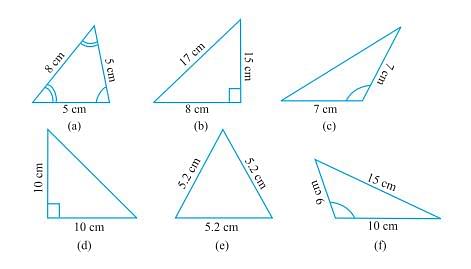Question:
Try to construct triangles using match sticks. Some are shown here. Can you make a triangle with:
(a) 3 matchsticks?
(b) 4 matchsticks?
(c) 5 matchsticks?
(d) 6 matchsticks? (Remember you have to use all the available matchsticks in each case) If you cannot make a triangle, think of reasons for it.

Try to construct triangles using match sticks. Some are shown here. Can you make a triangle with:
(a) 3 matchsticks?
(b) 4 matchsticks?
(c) 5 matchsticks?
(d) 6 matchsticks? (Remember you have to use all the available matchsticks in each case) If you cannot make a triangle, think of reasons for it.

(a) 3 matchsticks?
(b) 4 matchsticks?
(c) 5 matchsticks?
(d) 6 matchsticks? (Remember you have to use all the available matchsticks in each case) If you cannot make a triangle, think of reasons for it.

Updated On: Dec 20, 2023
Hide Solution
Verified By Collegedunia
Solution and Explanation
(a) 3 matchsticks This is an acute angle triangle, and it is possible with 3 matchsticks to make a triangle because sum of two sides is greater than third side. 
(b) 4 matchsticks This is a square, hence with four matchsticks we cannot make triangle.
(c) 5 matchsticks This is an acute angle triangle, and it is possible to make triangle with five matchsticks, in this case sum of two sides is greater than third side. 

(d) 6 matchsticks This is an acute angle triangle, and it is possible to make a triangle with the help of 6 matchsticks because sum of two sides is greater than third side.
Was this answer helpful?
0
0
Top Questions on Classification of Triangles
- What is an equilateral triangle?
- UP Board X - 2025
- Chitrakala
- Classification of Triangles
- Number of Triangles in given figure:

- CUET (UG) - 2023
- Informatics Practices
- Classification of Triangles
- Name the types of following triangles:
(a) Triangle with lengths of sides 7 cm, 8 cm and 9 cm.
(b) \(∆ABC\) with AB = 8.7 cm, AC = 7 cm and BC = 6 cm.
(c) \(∆PQR\) such that PQ = QR = PR = 5 cm.
(d) \( ∆DEF\) with m\(∠\) D = 90°
(e) \(∆XYZ\) with m \(∠\)Y = 90° and XY = YZ.
(f) \(∆LMN\) with m \(∠\)L = 30°, m \(∠\)M = 70° and m \(∠\)N = 80°.- CBSE Class VI
- Mathematics
- Classification of Triangles
- Name each of the following triangles in two different ways: (You may judge the nature of angle by observation)

- CBSE Class VI
- Mathematics
- Classification of Triangles
- Match the following:
Measure of Triangle Types of Triangle (i) 3 sides of equal length (a) Scalene (ii) 2 sides of equal length (b) Isosceles right angle (iii) All sides are of different length (c) Obtuse angle (iv) 3 acute angles (d) Right angle (v) 1 right angle (e) Equilateral (vi) 1 obtuse angle (f) Acute angle (vii) 1 right angle with two sides of equal length (g) Isosceles - CBSE Class VI
- Mathematics
- Classification of Triangles
Questions Asked in CBSE Class VI exam
- Aakash bought vegetables weighing 10 kg. Out of this, 3 kg 500 g is onions, 2 kg 75 g is tomatoes and the rest is potatoes. What is the weight of the potatoes?
- CBSE Class VI
- Subtraction of Decimals
Draw:
1) a leaf
2) a taproot and
3) a flower,
you have studied for Table 4.3
- CBSE Class VI
- The Leaf
Explain why the bulb would not glow in the arrangement shown in Fig. 9.13.

- CBSE Class VI
- A Bulb Connected To An Electric Cell
- Would the bulb glow in the circuit shown in Fig. 9.15?

- CBSE Class VI
- Electric Circuit
- The weight of 72 books is 9 kg. What is the weight of 40 such books?
- CBSE Class VI
- Unitary Method
View More Questions